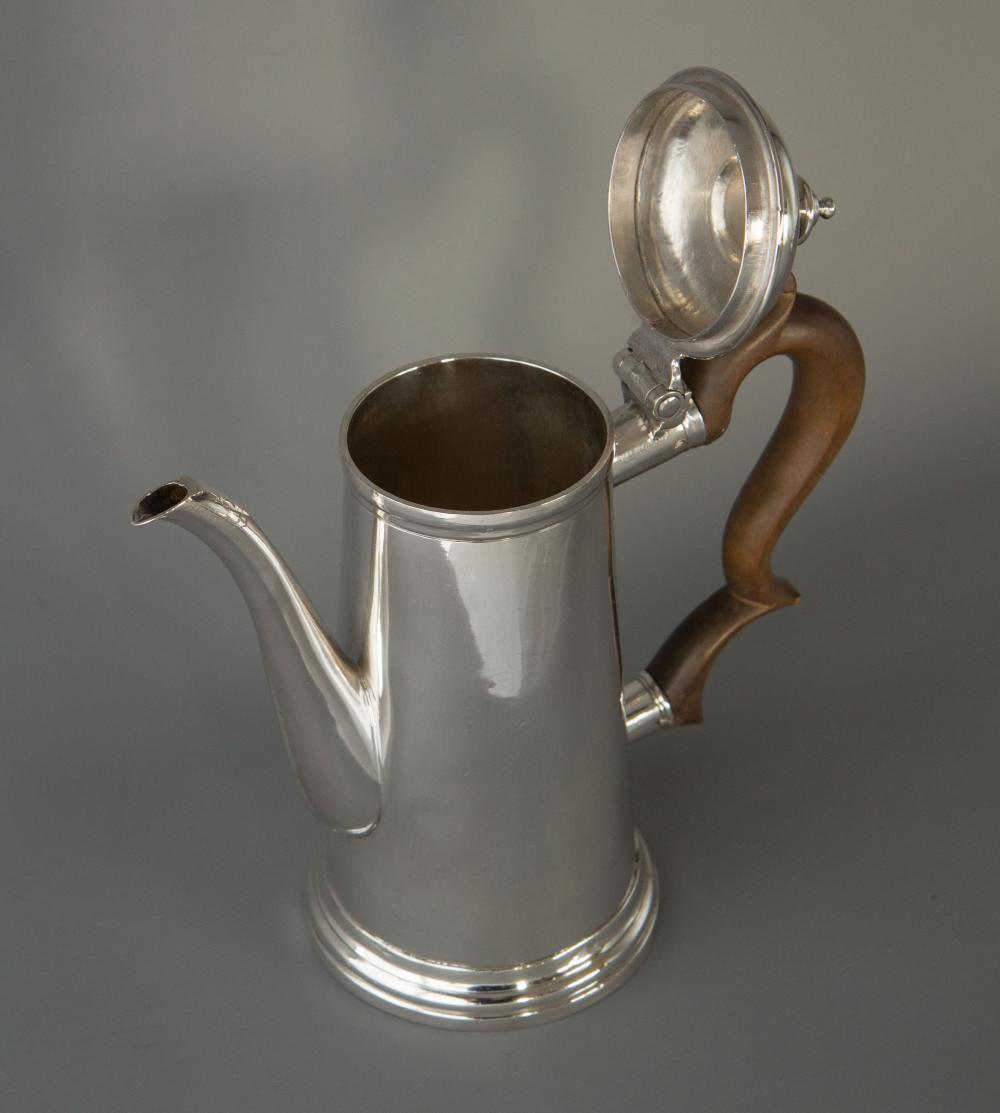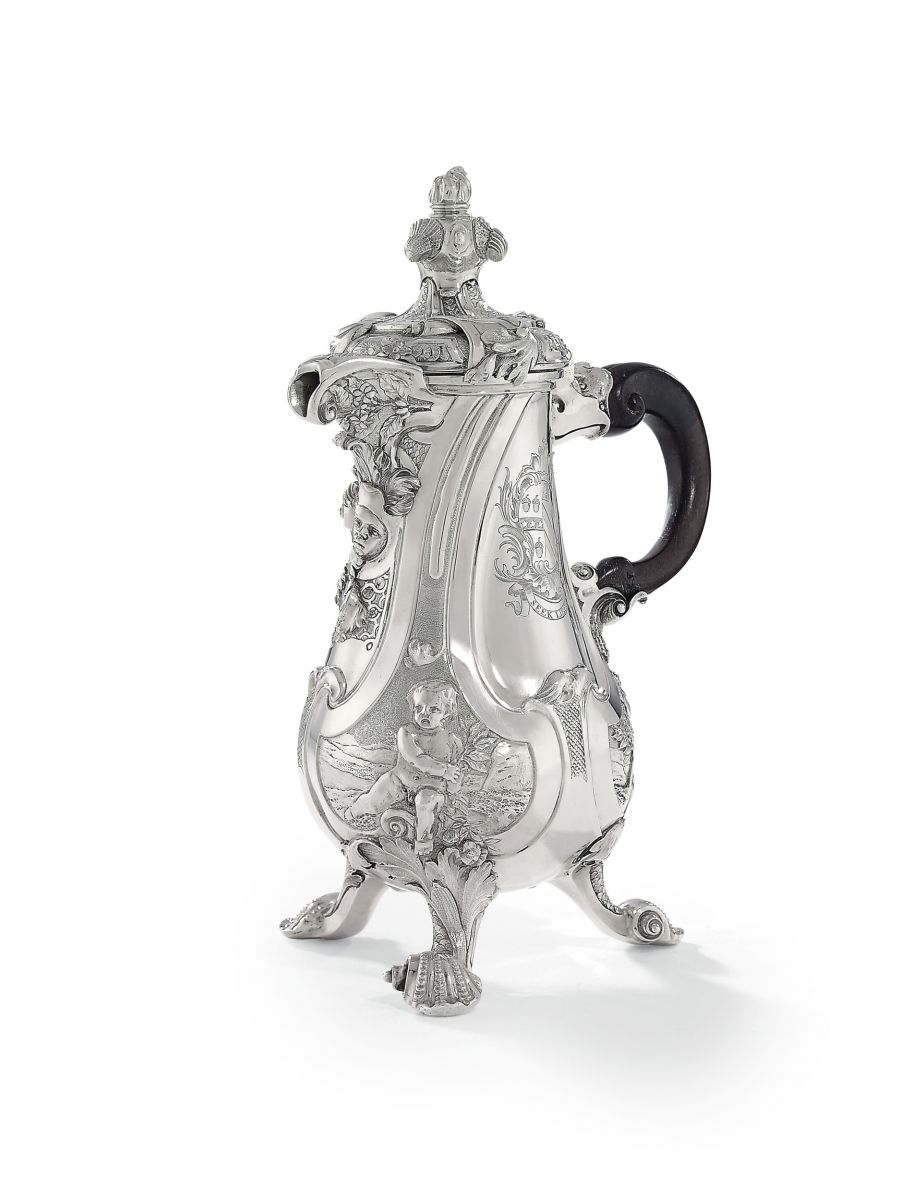Coffee Pot - The History
The Dawn of the Coffee Pot

A Superb Queen Anne Irish Silver Coffee Pot - 1706 Dublin
The processes of brewing and serving coffee have changed somewhat over the years. The earliest form of the drink was made in an old brewing pan of hot water, using a cloth to then filter the brewed water through. In 1710 furthermore, the brewing process of coffee was taken one step further: the coffee was wrapped in a linen cloth and this was then placed in the pan of boiling water to help get a stronger brew. As popularity and demand for coffee grew in the 1700s, so did the need for specialised vessels such as coffee pots. These pots were specially designed for the brewing of coffee, featuring an attached lid to help the infusion process. The bottom of the pot would be made wider than the top in order to help catch the sinking coffee grounds; spouts on the side were added for the same purpose. Another reason for the sudden necessity of coffee pots was so that coffee could be consumed within the house. As a result of the fact that women were excluded from the 3,000 or more nationwide coffee houses, a design specific to the home became necessary; coffee could now be enjoyed as a part of family life.
As the centuries progressed, the social aspects of coffee drinking expanded and there was therefore a need to produce larger quantities of coffee. This resulted in the dawn of the coffee urn.
The Evolution of the Coffee Pot
Silver coffee pots were first used by Pascal at St. Germain's fair in Paris, 1672. From this point onwards, English and American silversmiths began to create the most amazing forms of silver coffee pots. At the beginning of the 18th Century the consumption of coffee (as well as other beverages including tea and chocolate) escalated in popularity, resulting in the mass manufacture of coffee pots. Coffee pots were largely akin to chocolate pots, the only distinction being that the finial of chocolate pots could be removed so that a rod could be inserted to stir the chocolate. Because of this surge of popularity, the 1700s saw the dawn of beautiful coffee pots, particularly those with tapering panelled forms. There are some magnificent examples from this period: from plain cylindrical forms to pear shaped deeply fluted bodies and elegant flat chased ornamentation.
Soon after this, coffee pots began to be crafted in a tapered cylinder shape with a high domed cover. The spout was placed low on the body, along with the classic right-angled handle. Octagonal designs were introduced circa 1710. This style encompassed a flatter wider base, along with a top in the tear-shaped drop form.
The spouts on pots weren’t placed on the opposite side of the handle till the 1720s. The incurved base of the coffee pot became standard in the 1730s along with the plain tapered form.
The pear-shaped coffee pot came into fashion around the 1740s and prevailed until the 1760s. These jugs tended to sport shorter spouts than the previous type. This design is likely to have been originally intended for Turkish coffee which was of a much thicker consistency.
During the rococo (or ‘late baroque’) era the popular style of coffee pot changed yet again. The pots became massive and even more impressive, in a more ornate style. Festoons also became a prominent ornament. In the late 18th Century some beautiful examples were crafted by the likes of Paul De Lamerie; they featured classic rococo ornamentation which consisted of flowing, asymmetric details and natural motifs including shells (which would often be the chosen shape for a finial). This renowned London silversmith was (and still is) well recognised for his craftsmanship in producing fine and collectable coffee pots. One coffee pot created by him sold at auction in 2013 for around £4.5 million!

"The Lequesne Coffee-Pot"
By the 1780s, filters were added to coffee pots in the form of a cloth or sock placed over the mouth. Coffee grounds were placed in the sock and hot water was then poured over them. ‘Mr. Biggin Coffee Pots’ was the first company to introduce a coffee pot with a place for the filter and these pots received instant popularity. A prevalent issue however with this seemingly ingenious advancement, was that the taste of the cloth filter was often undesirably transferred to the coffee itself. This is problem that was not overcome until 1908 when the paper coffee filter was invented by German entrepreneur Melitta Bentz.
By the early 1800s, espresso machines and coffee percolators were introduced (circa 1818), and by the end of the century, the plunger filter was invented. The Napier vacuum coffee machine came in to the game in 1840, and then the first drip coffee maker was introduced in 1908.Thus began the demise of the coffee pot.
Today however, coffee pots remain collectable and desirable items, particularly those crafted in high quality sterling silver or by specifically important makers.
